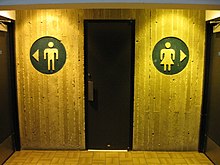Gender segregation
Gender separation refers to different ways of differentiating , separating or segregating living beings with regard to their biological gender and / or their cultural gender . In social and cultural terms, gender segregation is an expression of a gender order . The gender order becomes important as soon as it is used to discriminate , historically mostly women . This can range from monoeducation (gender-related school attendance rates in the past and present of different countries) to the killing of allegedly socially undesirable individuals ( killing women - femicide) .
meaning

In particular, denotes gender segregation
- school and educational measures for the separate education of boys and girls , also known as seed education . The opposite term is co-education .
- in everyday language the spatial separation according to gender , z. B.
- for toilets (see, on the other hand, unisex toilets );
- Women parking spaces
- in the form of a specific seating arrangement at church services (cf. men and women side , mechiza , gender segregation in mosques ).
- Gender segregation in sport in the form of separate leagues, e.g. B. Women's football
- at clubs and associations, e.g. B. in men's and women's clubs , z. B. Women's Choir ; Men's order , women's order ( women's monastery )
- the culturally, ritually or legally binding division of the various areas of life in a society into man and woman spheres , traditionally often as pairs of opposites: public and private, employment and household, society and family, street and house.
- more generally the existence of different spheres of gender-specific action , e.g. B. Women's literature , women's film , women's library
- as a biological term, the formation or diversification of sexual beings in the context of phylogenetic or ontogenetic development. See also gender dimorphism .
The segregation of the sexes in which the living space of a gender, almost always the woman, is largely restricted to a space that is separate from the public and insofar as it is closed off, is called seclusion . Particularly strict forms of seclusion can be found e.g. B. in some traditional Muslim societies in the Arabian Peninsula and Africa.
In the English-speaking world , gender segregation in the sense of 2 and 3 is referred to as "sex segregation" or - in an anti-discriminatory direction - as "sexual apartheid".
The visible emphasis on the different sex beings, e.g. B. through clothing, hairstyle, cosmetics, language and behavior, can be viewed in the sense of (4) as a manifestation of gender segregation. Some forms of dress and taboos also serve to largely prevent public interaction between the sexes. In particular, fundamentalist religious groups, such as the supporters of the Salafiyya and several ultra-Orthodox Jewish groups , advocate strict gender segregation in public space.
See also
Web links
Individual evidence
- ↑ Israel's President calls for protest against ultra-Orthodox , Zeit Online, December 27, 2011
- ↑ Thousands of Israelis demonstrate against religious fundamentalists , Zeit online, December 27, 2011
